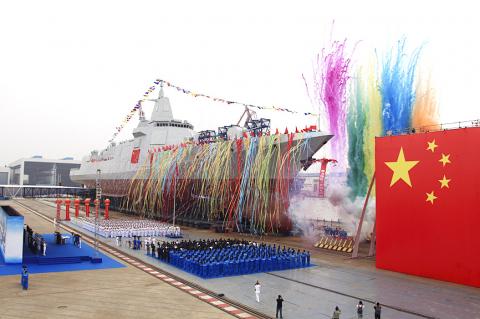The launch of China’s first Type 055 guided missile destroyer on Wednesday marks a significant increase in the threat to Taiwan posed by the Chinese People’s Liberation Army Navy (PLAN), observers in Taiwan said.
At 10,000 tonnes, the destroyers have a large displacement and are believed to possess advanced air defenses, as well anti-submarine and cruise-missile capabilities, they said.
Although it is unlikely that the warships were developed to fight the Taiwanese military, they expose the nation’s east coast — which is studded with military bases — to missile strikes, they added.

Photo: AP
The destroyers are to be the mainstay of the PLAN’s carrier escort fleets. The Soviet-built Liaoning is China’s sole operational carrier, as the PLAN has yet to declare its sister ship, which was launched in April, operational.
Another carrier is under construction.
Due to its small aircraft complement, the Liaoning is adequate for air defense, but not suited for offensive missions, said Chieh Chung (揭仲), a research fellow at the National Policy Foundation, a Chinese Nationalist Party (KMT) think tank.
The small size of the Liaoning’s air wing is the result of inherent design limitations, such as its ski-jump flight deck, he said.
“However, with the deployment of Type 055 destroyers, the Chinese carrier battle group’s ground-attack capabilities are enhanced. For example, a Type 055 destroyer can attack our facilities, such as the Chiashan (佳山) Air Base [in Hualien County], from the far seas to the east by cruise missiles,” Chieh said.
Such attacks would tax the military’s ability to defend the nation, he said.
The best way to counter the new breed of Chinese destroyers is a capable submarine flotilla, Chieh said, adding that the government should find foreign technical assistance to acquire and maintain such assets.
Democratic Progressive Party Legislator Tsai Shih-ying (蔡適應) said the PLAN’s guiding philosophy is to make China a major sea power, and that it has set objectives for the fleet’s immediate, intermediate and long-term futures.
“The PLAN’s objectives are securing its existing maritime interests in the immediate future, extending its sphere of influence to the Taiwan Strait and South China Sea in the interim, then projecting its naval power at the Strait of Malacca in the long-term,” Tsai said.
It is more likely that China is building the new destroyers to fulfill its long-term strategic vision, rather than attacking Taiwan, he said.
However, if China expels the US and its allies from the region and becomes Southeast Asia’s hegemonic power before starting a war against Taiwan, the nation’s ability to resist such an attack would be an open question, he said.
Taiwan needs to have an arsenal of missiles, because the ability to deter or destroy PLAN’s surface combatants in the initial stage of a conflict is crucial to winning a naval battle with China, Tsai said.
“The unit cost of missiles is less than that of submarines. In addition, the latter are far more vulnerable to saturation attacks. Using the Chungshan Institute of Science and Technology to develop mid and long-range missiles that can overcome anti-missile defenses is an option the military should weigh carefully,” he said.
The PLAN’s expansion is likely being carried out to augment China’s regional influence in tandem with its “One Belt, One Road” initiative, rather than to attack Taiwan, an unnamed Ministry of National Defense official said.
As the destroyers become a mainstay of Chinese surface fleets, they will boost the PLAN’s anti-air capability and its munition payloads, the official said.
However, sheer tonnage does not have a direct correlation with combat capabilities, and the Taiwanese navy’s Touchiang-class corvettes and missiles should be capable of countering the Chinese destroyers, the official said.

‘DENIAL DEFENSE’: The US would increase its military presence with uncrewed ships, and submarines, while boosting defense in the Indo-Pacific, a Pete Hegseth memo said The US is reorienting its military strategy to focus primarily on deterring a potential Chinese invasion of Taiwan, a memo signed by US Secretary of Defense Pete Hegseth showed. The memo also called on Taiwan to increase its defense spending. The document, known as the “Interim National Defense Strategic Guidance,” was distributed this month and detailed the national defense plans of US President Donald Trump’s administration, an article in the Washington Post said on Saturday. It outlines how the US can prepare for a potential war with China and defend itself from threats in the “near abroad,” including Greenland and the Panama

The Chinese Nationalist Party (KMT) is maintaining close ties with Beijing, the Democratic Progressive Party (DPP) said yesterday, hours after a new round of Chinese military drills in the Taiwan Strait began. Political parties in a democracy have a responsibility to be loyal to the nation and defend its sovereignty, DPP spokesman Justin Wu (吳崢) told a news conference in Taipei. His comments came hours after Beijing announced via Chinese state media that the Chinese People’s Liberation Army’s Eastern Theater Command was holding large-scale drills simulating a multi-pronged attack on Taiwan. Contrary to the KMT’s claims that it is staunchly anti-communist, KMT Deputy

RESPONSE: The government would investigate incidents of Taiwanese entertainers in China promoting CCP propaganda online in contravention of the law, the source said Taiwanese entertainers living in China who are found to have contravened cross-strait regulations or collaborated with the Chinese Communist Party (CCP) could be subject to fines, a source said on Sunday. Several Taiwanese entertainers have posted on the social media platform Sina Weibo saying that Taiwan “must be returned” to China, and sharing news articles from Chinese state media. In response, the Mainland Affairs Council (MAC) has asked the Ministry of Culture to investigate whether the entertainers had contravened any laws, and asked for them to be questioned upon their return to Taiwan, an official familiar with the matter said. To curb repeated

Myanmar has turned down an offer of assistance from Taiwanese search-and-rescue teams after a magnitude 7.7 earthquake struck the nation on Friday last week, saying other international aid is sufficient, the National Fire Agency said yesterday. More than 1,700 have been killed and 3,400 injured in the quake that struck near the central Myanmar city of Mandalay early on Friday afternoon, followed minutes later by a magnitude 6.7 aftershock. Worldwide, 13 international search-and-rescue teams have been deployed, with another 13 teams mobilizing, the agency said. Taiwan’s search-and-rescue teams were on standby, but have since been told to stand down, as